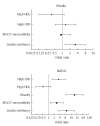ADV36 adipogenic adenovirus in human liver disease
- PMID: 25356033
- PMCID: PMC4209536
- DOI: 10.3748/wjg.v20.i40.14706
ADV36 adipogenic adenovirus in human liver disease
Abstract
Obesity and liver steatosis are usually described as related diseases. Obesity is regarded as exclusive consequence of an imbalance between food intake and physical exercise, modulated by endocrine and genetic factors. Non-alcoholic fatty liver disease (NAFLD), is a condition whose natural history is related to, but not completely explained by over-nutrition, obesity and insulin resistance. There is evidence that environmental infections, and notably adipogenic adenoviruses (ADV) infections in humans, are associated not only with obesity, which is sufficiently established, but also with allied conditions, such as fatty liver. In order to elucidate the role, if any, of previous ADV36 infection in humans, we investigated association of ADV36-ADV37 seropositivity with obesity and fatty liver in humans. Moreover, the possibility that lifestyle-nutritional intervention in patients with NAFLD and different ADV36 seropositive status, achieves different clinical outcomes on ultrasound bright liver imaging, insulin resistance and obesity was challenged. ADV36 seropositive patients have a more consistent decrease in insulin resistance, fatty liver severity and body weight in comparison with ADV36 seronegative patients, indicating a greater responsiveness to nutritional intervention. These effects were not dependent on a greater pre-interventional body weight and older age. These results imply that no obvious disadvantage - and, seemingly, that some benefit - is linked to ADV36 seropositivity, at least in NAFLD. ADV36 previous infection can boost weight loss and recovery of insulin sensitivity under interventional treatment.
Keywords: Human adenovirus 36; Insulin resistance; Mediterranean diet; Non-alcoholic fatty liver disease; Obesity; Ultrasound.
Figures








References
-
- Roden M. Mechanisms of Disease: hepatic steatosis in type 2 diabetes--pathogenesis and clinical relevance. Nat Clin Pract Endocrinol Metab. 2006;2:335–348. - PubMed
-
- Younossi ZM, Stepanova M, Negro F, Hallaji S, Younossi Y, Lam B, Srishord M. Nonalcoholic fatty liver disease in lean individuals in the United States. Medicine (Baltimore) 2012;91:319–327. - PubMed
-
- Yeh MM, Brunt EM. Pathology of nonalcoholic fatty liver disease. Am J Clin Pathol. 2007;128:837–847. - PubMed
Publication types
MeSH terms
Substances
LinkOut - more resources
Full Text Sources
Other Literature Sources
Medical

